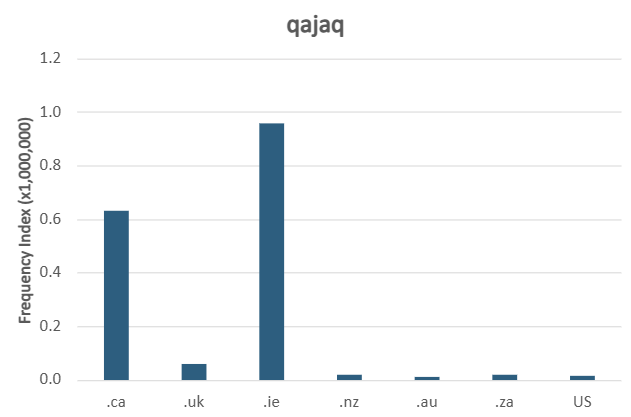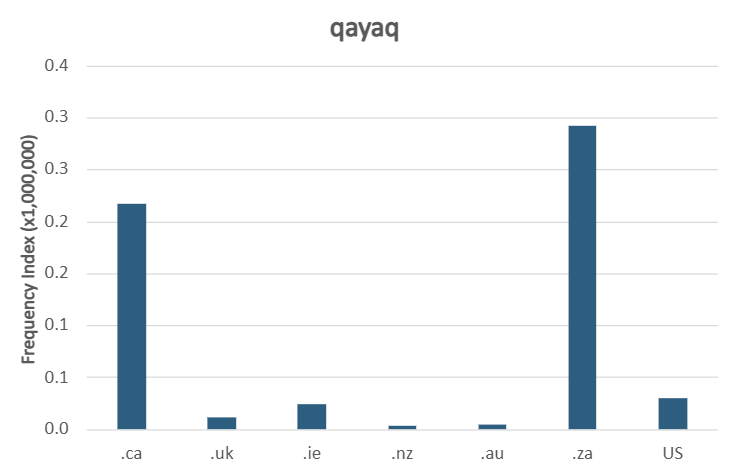Quick links
qajaq
< Eastern Inuktitut
DCHP-3 (Apr 2025)
Spelling variants:qayak
Qajaq is today considered the decolonized variant spelling for what traditionally, in Canadian English, has been spelled kayak. It enters Canadian English in the 1990s, spelling qayaq in the 1980s (see the 1986 and 1997 quotations)
n. — Sports, Indigenous, Outdoors, originally North & Territories
a light sealskin boat completely decked except for a cockpit (see Image 1).
Type: 1. Origin — A borrowing from Inuktitut, qajaq is one of the most iconic linguistic items pertaining to Canada. See details under the entry kayak.
The spelling with a medial j, qajaq, is both older and more frequent today (by a factor of 10) than the spelling with a y, qayaq, which is more Anglicized (see also the first 2024 quotation). As the Inuit in Canada revive their qajaq-building traditions (see Image 1, see the second 2024 quotation), this spelling will be propagated.
Like many decolonized forms, these forms are not very frequent in the historical record. A gap between the early 1910s, when the term is found in anthropological and linguistic guides to Inuit lands, and the 1980s is noticeable. Canadiana.ca, a national repository for historical Canadian sources, for instance, lists only a handful of qajaq spellings around 1900 (see the 1887 quotation) in the context of the Inuit language and is usually rendered in the Roman alphabet with a j. There is, however, no single instance of qayaq, while kayak occurs 663 times in that database (12 Mar. 2024).
Chart 1 shows that qajaq is established in Canada, with a high frequency in Ireland as well. Chart 2 depicts the spelling qayaq, which demonstrates high frequencies in South Africa, where it generally relates to the North American Inuit, and in Canada.
COD-2 lists qajaq merely as "var. of kayak" and not marked as Canadian.
The spelling with a medial j, qajaq, is both older and more frequent today (by a factor of 10) than the spelling with a y, qayaq, which is more Anglicized (see also the first 2024 quotation). As the Inuit in Canada revive their qajaq-building traditions (see Image 1, see the second 2024 quotation), this spelling will be propagated.
Like many decolonized forms, these forms are not very frequent in the historical record. A gap between the early 1910s, when the term is found in anthropological and linguistic guides to Inuit lands, and the 1980s is noticeable. Canadiana.ca, a national repository for historical Canadian sources, for instance, lists only a handful of qajaq spellings around 1900 (see the 1887 quotation) in the context of the Inuit language and is usually rendered in the Roman alphabet with a j. There is, however, no single instance of qayaq, while kayak occurs 663 times in that database (12 Mar. 2024).
Chart 1 shows that qajaq is established in Canada, with a high frequency in Ireland as well. Chart 2 depicts the spelling qayaq, which demonstrates high frequencies in South Africa, where it generally relates to the North American Inuit, and in Canada.
COD-2 lists qajaq merely as "var. of kayak" and not marked as Canadian.
See: kayak (1)
Quotations
1877
The kayak (qajaq) is almost exclusively used for hunting by all Eskimo tribes from Greenland to Alaska.
1915
[Kaiak, kayak. Le bâteau des hommes chez les Esquimaux du nord-est de l'Amerique du Nord; de qajaq (q=ch de l'allemand), son nom dans les dialectes orientaux de la langue esquimau. (A. F. C.)]
1986
This is the same sound that shows up in Inuktitut words like "nanuq" meaning polar bear, or "qayaq" meaning kayak. The DH represents the same sound as the TH in English words like "there" or "either" , and is doubled because it is held twice as long as the other sounds.
1997
On the northwest coast of Hudson Bay, kayak is usually spelled qayaq, and igloo is usually spelled iglu. There is a sense that southern people, usually spelled qallunaaq, never get it right.
1998
The board room's conference table is built around a life-sized, skin-covered qajaq (kayak) on top of an authentic qamutik (dog sled).
2005
When powerboats began to allow Inuit hunters and fishers to catch more game and travel farther with greater speed, kayaks were mostly abandoned -- until the early 1980s, when a movement began to preserve the traditional kayak. Interviews with elders resulted in a kayak-building manual that preserved the traditional construction methods and produced a new generation of kayakers, who in 1983 formed the Nuuk Qajaq Club.
2017
Last month, four boat builders and their assistants created a birch bark canoe, moose skin boat, skin qayak, and a dugout canoe.The four watercraft are now on display at the Yukon Transportation Museum until July 20.
2021
The Qajaq Program was developed to connect young people with local knowledge keepers and elders to learn how to build and paddle their own qajaqs.
2024
[Qayaq is the name of the traditional sealskin hunting boat of the Arctic Eskimo tribes (particularly the Inuit, the Yup'ik, and the Alutiiq.) In some Arctic tribes the same kind of boat is known as a baidarka instead, which comes from a word for "boat" in an indigenous Siberian language. The word qayaq is spelled many different ways including qajak, qayak, kayaq, and kayak. Plural forms include qajat and qayat, although the anglicized plural "kayaks" is most common these days.]
2024
From 1016-2021 [sic], the first qajait (the Inuit word for three or more of the vessels), were built in West Greenlandic style “because those were the resources that were available to us at the beginning,” explains Comeau, “until we were able to start working with some Elders from our region. Since 2020-2021, we’ve evolved to start building the South Baffin-style qajaq. Alongside [developing] our own regional style, we’ve been developing regional programs.”
References
- COD-2 • qajaq
Images

Image 1: Inuit seal hunter in a qajaq armed with a harpoon (photo: Ville Miettinen)

Chart 1: Internet Domain Search, 7 May 2025
